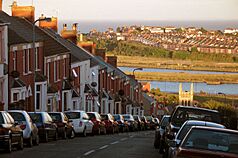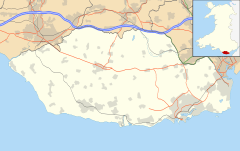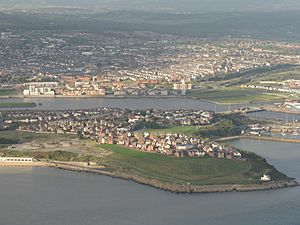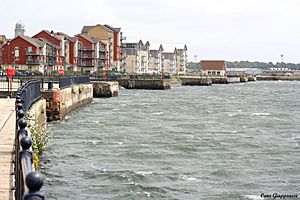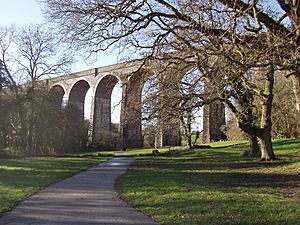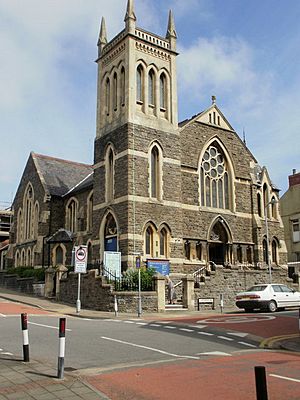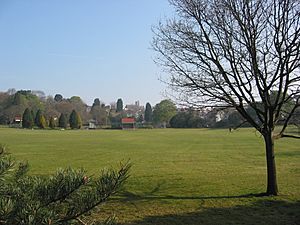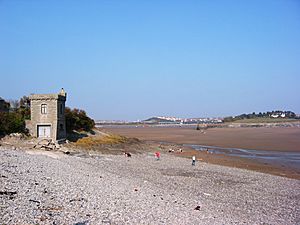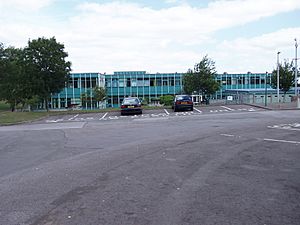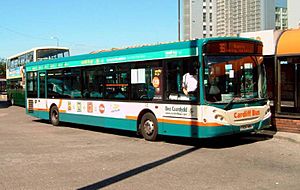Barry, Vale of Glamorgan facts for kids
Quick facts for kids Barry
|
|
|---|---|
|
|
|
| Population | 51,502 |
| OS grid reference | ST119682 |
| • Cardiff | 9.9 miles (15.9 km) |
| • London | 164.1 miles (264.1 km) |
| Community |
|
| Principal area |
|
| Ceremonial county | |
| Country | Wales |
| Sovereign state | United Kingdom |
| Post town | BARRY |
| Postcode district | CF62–63 |
| Dialling code | 01446 |
| Police | South Wales |
| Fire | South Wales |
| Ambulance | Welsh |
| EU Parliament | Wales |
| UK Parliament |
|
| Welsh Assembly |
|
Barry (also known as Y Barri in Welsh) is a town and community in the Vale of Glamorgan, Wales. It is located on the north coast of the Bristol Channel. Barry is about 16 kilometers (9.9 miles) southwest of Cardiff.
Barry is a popular seaside resort. It has several beaches and the fun Barry Island Pleasure Park. In 2021, about 56,605 people lived in Barry. The town has grown to include nearby villages like Cadoxton and Barry Island. Barry grew a lot from the 1880s because of the Barry Docks. In 1913, these docks became the biggest coal port in the world.
Contents
What Does the Name Barry Mean?
The name of Barry has a debated origin. Some believe it comes from Baruc, a saint from the 6th century. He was buried on Barry Island, where a ruined chapel was dedicated to him. Others think the name comes from the Welsh word bar. This word means "hill" or "summit." In Welsh, the name Y Barri includes the word "the."
Discovering Barry's Past
Early History of Barry
People have lived in the Barry area for a very long time. Tools from the Middle Stone Age have been found on Barry Island. Polished stone axe-heads from the New Stone Age were also found nearby. Pottery urns with ashes from the Bronze Age were discovered on Barry Island. A large hillfort from the Iron Age was located at the Bulwarks in Porthkerry. There was also an early Iron Age farmstead found near Barry College.
During Roman times, farmhouses existed where Barry Castle and Biglis are now. Roman bricks and tiles were reused in St. Baruc's Chapel and St. Nicholas Church. A Roman villa was found in Llandough. In 1980, a Roman building with 22 rooms was found at Glan-y-môr. It is thought to be a 3rd-century building. It might have been a supply depot for the navy.
The Vikings also launched raids in this area. Barry Island was known as a raider base in 1087. The islands of Flat Holm and Steep Holm in the Bristol Channel get their names from a Scandinavian word. This word means an island in a river mouth.
Medieval Times in Barry
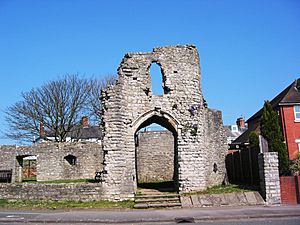
During the Middle Ages, Barry Island was separated from the mainland by water. Giraldus Cambrensis (Gerald of Wales) wrote about it in 1191. He said Barry was named after Saint Baruc. His remains were in a chapel on the island. The noble family who owned the island took the name de Barri from it.
After the Norman conquest of England, the area was divided into manors. The Barry area was split into two large lordships: Penmark and Dinas Powys. The de Barri family was given the Barry manor. Their home was Barry Castle, built on a hill overlooking the Bristol Channel. The castle was a small fortified manor house. It replaced an older earthwork. By the late 13th century, the castle had two stone buildings. In the early 14th century, a large hall and gatehouse were added. Only their ruins remain today.
Barry grew into a village and port with a church and watermill. But in the 14th century, its population dropped a lot. This was due to the Black Death and the rebellion of Owain Glyndŵr. It took about 300 years for the population to recover. By 1622, the fields around Barry village looked much as they would until the modern town grew. In 1673, there were only thirteen houses in the parish.
Whitehouse Cottage is the oldest house still lived in today in Barry. It was built in the late 1500s. It overlooks the sea at Cold Knap.
Barry's Industrial Growth
By 1871, Barry had over 100 people and 21 buildings. It was still mostly a farming community. But it grew quickly when it became a coal port in the 1880s. The coal trade was growing too fast for the docks in Tiger Bay in Cardiff. So, a group of coal mine owners created the Barry Railway Company. They decided to build docks in Barry.
Work started in 1884. The first dock basin opened in 1889. Two more docks and many port buildings followed. The Barry Railway brought coal from the South Wales Valleys to the new docks. Trade grew from one million tons in the first year to over nine million tons by 1903. The port was busy with ships. It had ship repair yards, cold storage, flour mills, and an ice factory. By 1913, Barry was the biggest coal exporting port in the world. The Barry Council Office and Library was finished in 1908.
Behind the docks, rows of houses were built. Barry and Cadoxton soon became a large town. The railways also helped make Barry Island a popular holiday spot. The Barry Memorial Hall opened in 1932. It honors those who died in World War I.
The Barry Scrapyard Story
After diesel and electric trains became popular, many steam engines were no longer needed. The railway yards at Barry Docks became the biggest place where steam engines waited to be scrapped. Dai Woodham owned the Woodham Brothers Scrap yard. He let groups who wanted to save old trains buy them back. This saved about 200 of the 300 locomotives. Many were damaged while stored there. Mr. Woodham said that Barry's empty railway lines were the main reason these trains could be saved.
Barry Today
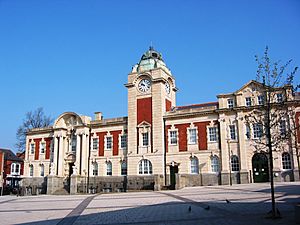
Barry is the main administrative center for the Vale of Glamorgan. It is also home to the football team Barry Town United F.C..
Barry is now more of a manufacturing town. It also provides services for the Vale of Glamorgan. The Barry Docks and the nearby industrial area are the biggest employers in town. Roads to the docks were greatly improved in 1981. Now, the docks have direct access to the M4 motorway. The docks can handle large ships. They are good for handling bulk goods. There are also places for leisure activities like rowing and sailing.
The town has a town council. The Labour Party controls it.
Most industrial companies are in the dock area. Large chemical companies like Cabot Carbon and Dow Corning are here. Dow Corning recently built the largest silicones plant in Europe. Other major employers include Jewson Builders' Merchants and Western Welding and Engineering. Associated British Ports Holdings has managed the docks since 1982.
West of Barry is Porthkerry Park. This is a large open area with woods and streams. It also has access to a pebbly beach. In the park is the old Barry Railway Company viaduct. It has 13 arches and is 33.5 meters (110 feet) high. A railway line through the park reopened in 2005. It offers scenic views and connects to Llantwit Major and Bridgend.
Exploring Barry Island

Barry Island was once a real island. It became connected to the mainland in the 1880s. This happened as the town of Barry grew. The Barry Railway Company built the Barry Dock, which filled the gap.
You can reach the island by train at Barry Docks. There is also a heritage railway station. It has restored steam passenger trains. This railway is open to the public. It even hosts events with a large steam engine that looks like Thomas the Tank Engine.
Today, Barry Island is famous for its beach and the Barry Island Pleasure Park. From 1966 to 1987, it was home to a Butlins Holiday camp. This camp was later used for filming parts of the Doctor Who show Delta and the Bannermen. The camp closed in 1996. It was redeveloped for housing between 1997 and 2003.
The preserved Vale of Glamorgan Railway runs on Barry Island.
The BBC comedy show Gavin & Stacey was filmed in many parts of Barry and Barry Island. Places like Marco's Café from the show are real. The medical drama Casualty also films scenes in Barry Island.
Barry's Neighborhoods
Barry has many different areas, including:
- Barry Dock
- Barry Island
- Barry Waterfront
- Buttrills
- Cadoxton
- Colcot
- Coldbrook
- Cwm Talwg
- Gibbonsdown
- Gladstone
- Highlight Park
- Holton
- Jenner Park
- Merthyr Dyfan
- Palmerstown
- Pencoedtre
- Romilly
Weather in Barry
Barry has a maritime climate, like the rest of the British Isles. This means it has cool summers and mild winters. It often has strong winds. Barry is one of the sunnier places in Wales. This is because it is in the south and by the coast. The closest weather station is at Cardiff Airport, about 5 kilometers (3 miles) west of Barry.
| Climate data for Rhoose 65m asl, 1971–2000 | |||||||||||||
|---|---|---|---|---|---|---|---|---|---|---|---|---|---|
| Month | Jan | Feb | Mar | Apr | May | Jun | Jul | Aug | Sep | Oct | Nov | Dec | Year |
| Mean daily maximum °C (°F) | 7.3 (45.1) |
7.5 (45.5) |
9.7 (49.5) |
12.0 (53.6) |
15.5 (59.9) |
18.2 (64.8) |
20.5 (68.9) |
20.4 (68.7) |
17.7 (63.9) |
14.0 (57.2) |
10.4 (50.7) |
8.3 (46.9) |
13.5 (56.3) |
| Mean daily minimum °C (°F) | 2.3 (36.1) |
2.0 (35.6) |
3.4 (38.1) |
4.5 (40.1) |
7.4 (45.3) |
10.1 (50.2) |
12.4 (54.3) |
12.4 (54.3) |
10.6 (51.1) |
8.0 (46.4) |
4.8 (40.6) |
3.3 (37.9) |
6.8 (44.2) |
| Average precipitation mm (inches) | 95 (3.7) |
69 (2.7) |
77 (3.0) |
60 (2.4) |
60 (2.4) |
64 (2.5) |
63 (2.5) |
83 (3.3) |
98 (3.9) |
106 (4.2) |
107 (4.2) |
103 (4.1) |
983 (38.7) |
| Mean monthly sunshine hours | 55 | 74 | 113 | 174 | 212 | 208 | 220 | 207 | 150 | 103 | 74 | 49 | 1,639 |
| Source: MeteoFrance | |||||||||||||
Arts and Culture in Barry
Barry has been a setting for many TV shows and films:
- The TV series Being Human (2010 onwards) was filmed around Barry Island.
- The 2011 film Submarine was mostly filmed in Barry.
- Barry hosted the National Eisteddfod of Wales in 1920 and 1968. This is a major Welsh festival.
- The Doctor Who episode Delta and the Bannermen was set and filmed in Barry.
- Other Doctor Who episodes like "The Empty Child" were filmed at the Vale of Glamorgan Railway in 2005.
- The popular sitcom Gavin & Stacey is partly set and filmed in Barry.
Art Central is a modern art gallery in the Town Hall. It opened in 2006. Watercolour artist Thomas Frederick Worrall lived in Barry. Many of his paintings are in the National Library of Wales. Composer Grace Williams (1906–1977) was born in Barry. She is known as Wales's most famous female composer.
The Memo Arts Centre on Gladstone Road is the largest arts center in the Vale of Glamorgan. It shows live performances and movies. The Small Space on Island Road is known as "The World's Smallest Magic Theatre". It also hosts jazz and comedy shows.
Schools in Barry
Secondary Schools
Barry has four secondary schools for students aged 11-18.
- Whitmore High School (mixed)
- Pencoedtre High School (mixed)
- St Richard Gwyn Catholic High School (mixed, 11-16)
- Ysgol Gyfun Bro Morgannwg (Welsh-medium school, mixed)
Primary Schools
Many primary schools serve children aged 5-11 in Barry. These include community, Welsh-language, and faith-based schools.
- All Saints Church in Wales Primary School
- Barry Island Primary School
- Cadoxton Primary School
- Colcot Primary School
- Gladstone Primary School
- High Street Primary School
- Holton Primary School
- Jenner Park Primary School
- Oakfield Primary School
- Palmerston Primary School
- Romilly Primary School
- St Helen's RC Infants School (5–7)
- St Helens's RC Junior School (7–11)
- Ysgol Gwaun y Nant – Welsh-medium school
- Ysgol Nant Talwg – Welsh-medium school
- Ysgol Sant Baruc – Welsh-medium school
- Ysgol Sant Curig – Welsh-medium school
Sports in Barry
Barry is home to several sports teams:
- Barry Town F.C. (football)
- Barry RFC (rugby)
- Sea View RFC (rugby)
- Barry 40 (running event)
Getting Around Barry
You can travel around Barry by bus and train. Cardiff Bus runs services to nearby towns and Cardiff City Centre. Barry's main bus station is at King's Square. The A4050 road connects Barry to Cardiff.
There are four railway stations in Barry: Barry, Barry Docks, Barry Island, and Cadoxton. These stations are part of the Valley Lines network. Trains run to Bridgend and Cardiff. Barry is also less than 5 kilometers (3 miles) east of Cardiff International Airport.
Places Near Barry
- Barry Island, now connected to the mainland by a road and railway.
- The Bendricks, a rocky beach near the harbor.
- Sully Island, a small island that can be reached at low tide.
- Sully, a village east of Barry.
Famous People from Barry
Many notable people have connections to Barry:
- Grace Williams (1906–1977), a famous Welsh composer.
- Gwynfor Evans (1912–2005), a Welsh politician and leader of Plaid Cymru.
- Julia Gillard (born 1961), who became the 27th Prime Minister of Australia.
- Derek Brockway (born 1967), a BBC Wales weather presenter.
- Lee Selby (born 1987), a former world champion boxer.
- Mike Bubbins (born 1972), a comedian and actor.
Freedom of the Town
Some people and military groups have been given the Freedom of the Town of Barry. This is a special honor.
Individuals
- Major Edgar Jones: 26 April 1950.
- Sophie Ingle: 18 October 2018.
Military Units
- RAF St Athan: 1959.
See Also
 In Spanish: Barry (Gales) para niños
In Spanish: Barry (Gales) para niños
Images for kids


